Few are as candid and historically accurate as hedge fund manager Kyle Bass when identifying structural breaks in the global economy. In a recent interview, Bass painted a grim but telling picture of China’s economic condition, warning:
“We are witnessing the largest macroeconomic imbalances the world has ever seen, and they are all coming to a head in China.”
While China has long been touted as the next great economic superpower, its recent trajectory reveals a far different story, one marked by policy missteps, systemic financial rot, and a rapidly eroding growth engine.
Bass didn’t mince words either:
“China’s economy is spiraling with no end in sight.”
China’s deflator, the broadest measure of prices across goods and services, continues to decline as economic activity erodes.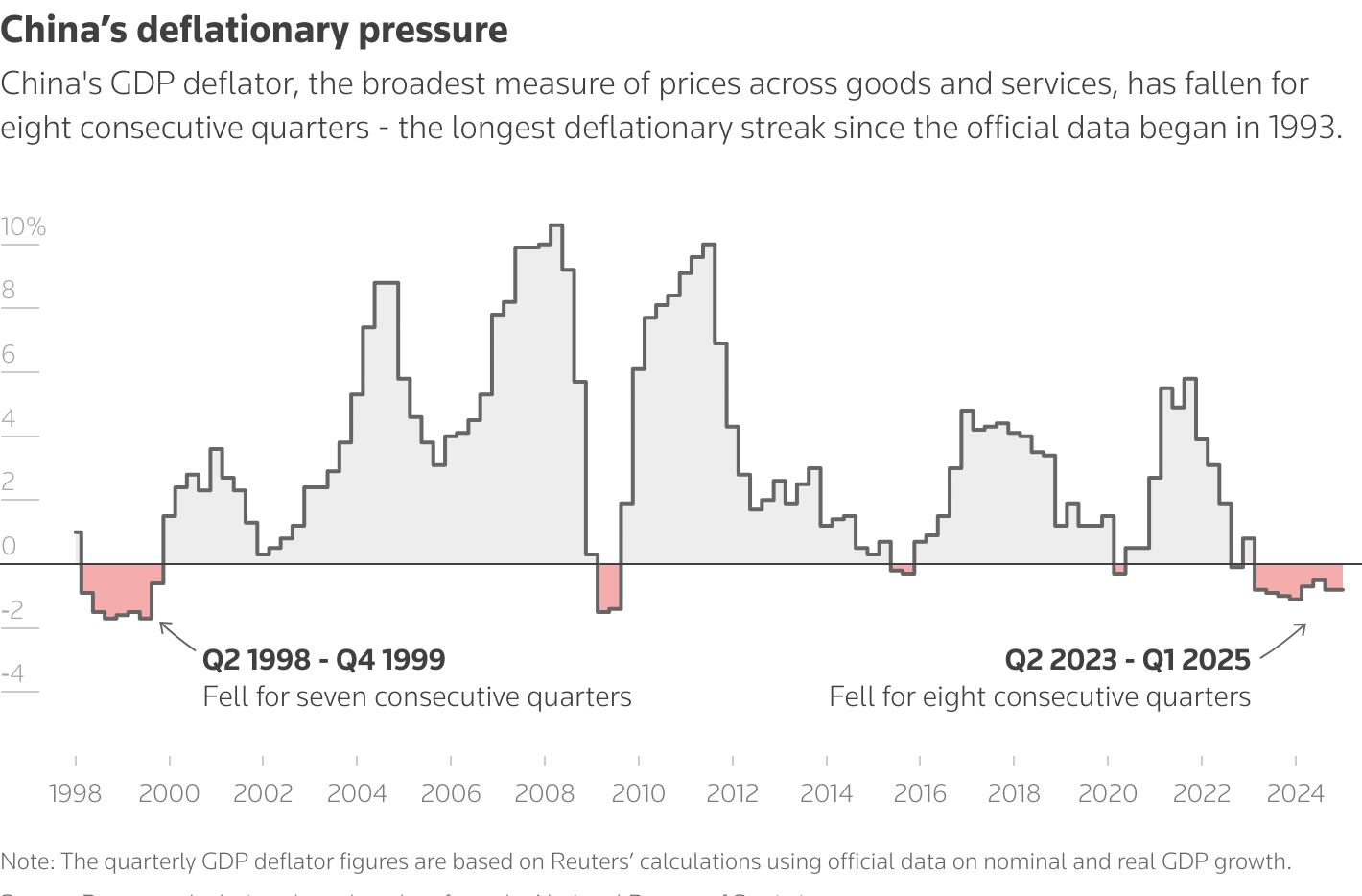
For investors around the globe, this isn’t just a regional concern; it’s a seismic macroeconomic event that will ripple through capital markets. The implications are significant for U.S. investors because when global economies falter, especially one as large and interconnected as China’s, capital doesn’t just vanish. It moves.
That movement will significantly impact US assets as flows transfer back into and Treasury bonds. This global repositioning of capital isn’t merely a symptom of market volatility; it reflects a profound reevaluation of risk in the face of deteriorating confidence in China’s financial system.
China’s Backstory
We must examine what’s breaking in China to understand why this matters so profoundly. Bass emphasized that the issue’s core lies in the real estate sector, which accounts for roughly 30% of China’s GDP. This massive share of economic activity is under severe strain, with property developers defaulting, sales volumes collapsing, and home prices declining across major cities.
However, this should be unsurprising as, after the financial crisis, we wrote many times about the mass overbuilding of “ghost cities” that were responsible for China’s growth at the time. However, the “bullwhip” effect of that massive overbuilding was inevitable.
“They’re sitting on 60 to 70 million vacant homes. It’s a Ponzi scheme that is finally collapsing.” – Kyle Bass
This particular real estate bubble, which is unprecedented in magnitude, is bursting. This creates deflationary pressures and undermines the value of collateral supporting large portions of China’s shadow banking system.
Adding to the concern is the Chinese Communist Party’s refusal to implement reforms that would bring greater transparency, capital discipline, and market-based corrections. Rather than allow markets to clear, Beijing is opting for control through capital restrictions, state intervention, and increased surveillance of financial activity.
“China is experiencing a slow-motion banking crisis, and capital is doing everything it can to escape.” – Kyle Bass.
That capital flight is inevitable and, as noted, will significantly impact the U.S. economy and financial markets.
Capital in Search of Safety
This exodus of domestic and foreign capital will reshape the global macro landscape. We recently discussed that the “” narrative was vastly exaggerated. While that post goes into more detail, there are five primary reasons why the dollar will remain the reserve currency of the world:
- Lack of a viable alternative currency
- Strength of the U.S. economy
- Network effects and global financial inertia
- Limited scope of de-dollarization efforts
- Resilience amid policy changes.
Most importantly, the dollar dominates the composition of global currency transactions.
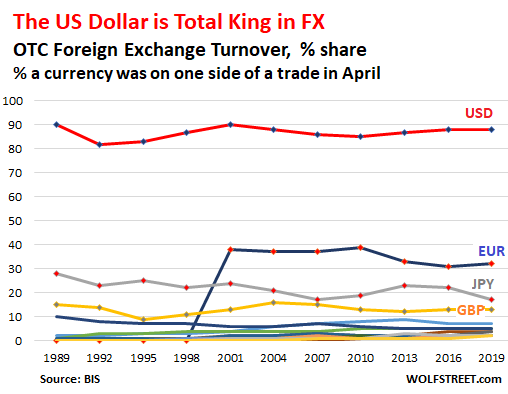
China’s economic collapse only exacerbates the world’s dependence on the U.S. dollar for trade and storing reserve assets to support that trade.
In times of crisis, investors don’t seek yield; they seek safety. Despite the U.S. running its fiscal imbalances and maintaining high levels of debt, the U.S. dollar and Treasury bonds remain the world’s premier safe havens. There is no alternative with the same depth, liquidity, and perceived security.
The Dollar Is Set To Rise
As capital flees China and other riskier markets, the U.S. dollar strengthens. This is not just a theoretical concept; it’s an observable pattern in every major crisis over the last several decades. The Global Financial Crisis, the Eurozone debt crisis, the COVID-19 pandemic, and the Russia/Ukraine conflict all prompted a sharp rally in the dollar as investors sought the perceived stability of the U.S. financial system.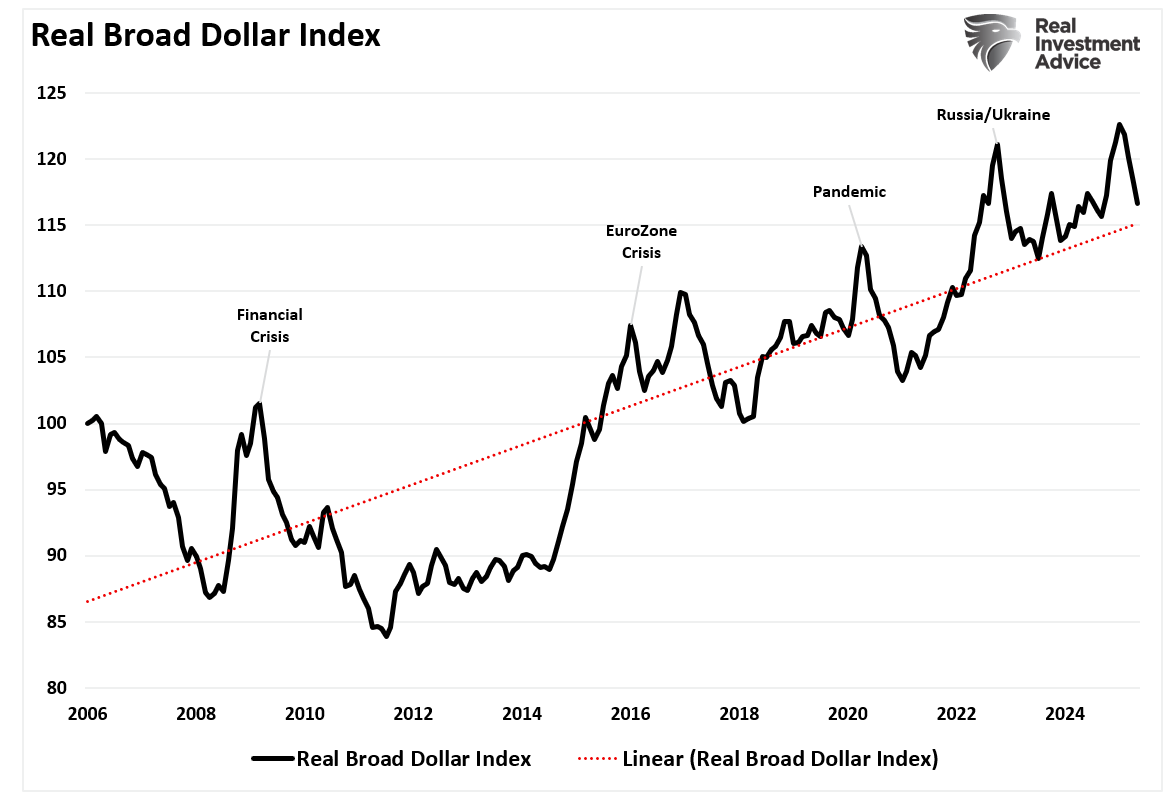
The mechanics of this are straightforward. When global capital flows into dollars, it often flows directly into U.S. Treasuries. Treasury securities remain the world’s deepest and most liquid sovereign debt market. As discussed in that same article, global Central Banks are cutting rates at one of the fastest paces on record. To wit:
“The ECB has been aggressively cutting rates, eight times in this recent cycle, while the U.S. Federal Reserve remains on hold. The result is a divergence that is developing between U.S. Treasury bond yields and, for example, the German Bund.”
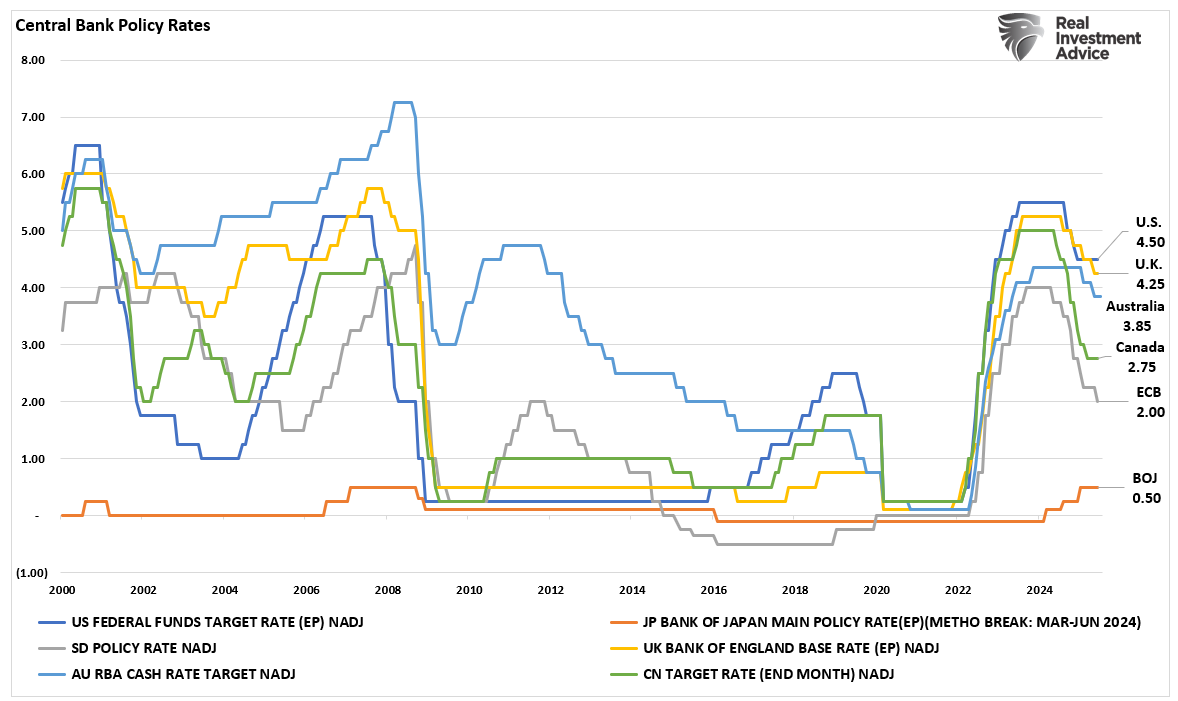
It is crucial to understand why this is so vital for investors.
- Higher yields attract capital inflows.
- Treasuries remain the preferred store of foreign reserves, and:
- Yield differentials drive dollar appreciation.
In other words, as the demand for Treasuries increases, bond prices push up and yields decline. Even when the U.S. is running record deficits and issuing vast amounts of new debt to fund government spending, foreign demand can offset the downward pressure this supply might otherwise have on prices.
In a stable global environment, one would expect rising Treasury issuance to push yields higher. But in a world where the second-largest economy is in decline and trust in its financial system is evaporating, Treasury bonds find buyers not because they offer high returns, but because they provide a guaranteed return of capital. That distinction is critical. Investors are not allocating capital for growth but reallocating it for preservation. That behavioral shift has enormous implications for markets.
China’s Deflationary Impact on the US
It also has consequences for the U.S. economy. The United States has benefited tremendously from China’s rise over the last 20 years. During that period, the U.S., through its corporations, could “export inflation” and “import deflation” via China’s cheap labor, rising middle class, and voracious demand for commodities and goods.
From industrial machinery to high-end consumer brands, China was a reliable marginal buyer for U.S. exports and a production partner for U.S. supply chains. As that engine falters, U.S. multinational earnings will increasingly come under pressure.
A structurally weakened China means less global trade, less demand for U.S. goods and services, and slower investment flows from international corporations. The knock-on effect will be lower nominal growth in the U.S., even if domestic consumption remains resilient. As such, markets will begin to price in a lower terminal growth rate for the U.S. economy, particularly in sectors exposed to international demand.
Moreover, China’s descent into deflation could export disinflationary pressures globally. That risk will likely exacerbate the risk that the Fed is making a “”
“This link between the economy and inflation is evident from the Economic Composite Index, which comprises nearly 100 hard and soft data points. Following the spike in economic activity post-pandemic, economic growth continues to decline. Given that inflation is solely a function of economic supply and demand, it is unsurprising that it continues to cool.”
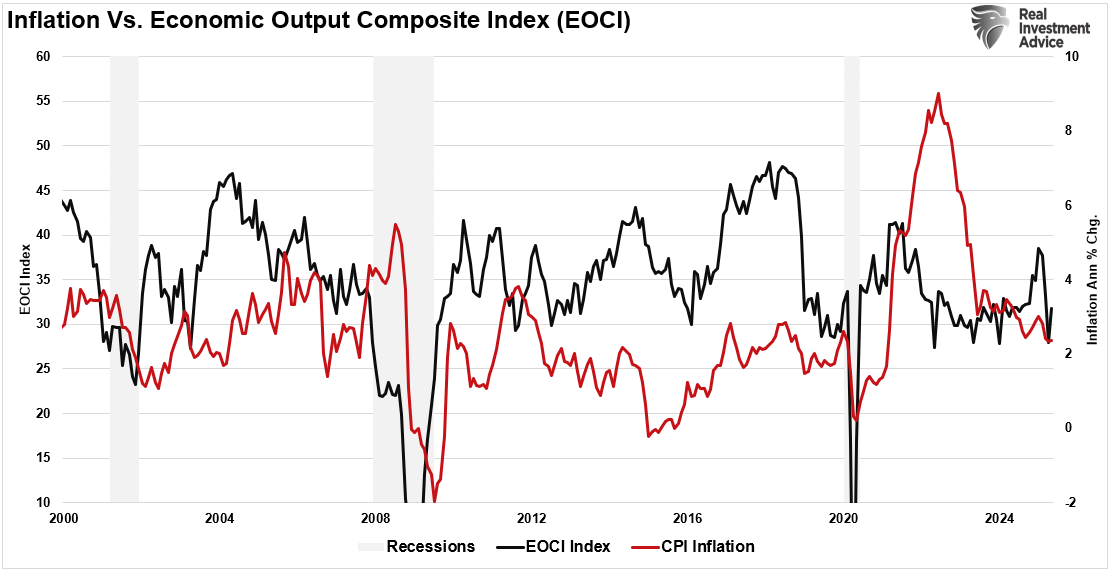
Understanding that the U.S. imports deflation from China, the risk of a sharper disinflationary impact from China on the U.S. will become evident in the economic data. As Bass noted:
“They’re not just dealing with a cyclical downturn. This is a permanent shift toward zero or negative real growth.”
That assessment has profound consequences for China and how policymakers and investors think about global growth in the decade ahead.
Conclusion
In this environment, the traditional drivers of market performance, earnings growth, productivity gains, and capital investment, will take a back seat to macro stability and risk management. Investors should shift their analysis from “Where can I grow my capital?” to “Where can I protect it?”
For now, the answer appears to be the U.S. Treasury market. Ironically, even with sticky fiscal deficits and political gridlock, capital prefers the U.S. over every alternative. That should tell us something.
As we’ve written many times before:
“Capital doesn’t care about ideology—it cares about trust, liquidity, and rule of law.”
When trust in a significant economic power like China evaporates, the resulting capital flows don’t walk, they run.
Investors would be wise to pay attention. The shift underway isn’t temporary. It reflects a deeper reordering of global economic leadership and risk tolerance. While the U.S. faces plenty of its structural challenges, it is still, for now, the cleanest shirt in a very dirty laundry pile.
